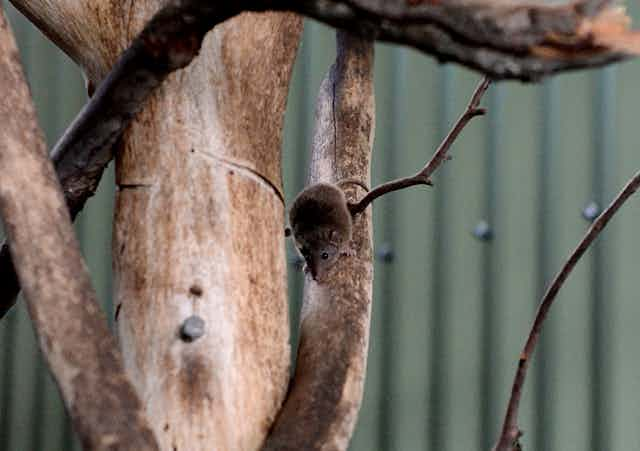Imagine you are crossing a stream over a fallen log. How fast would you walk across? Probably fairly slowly, balancing carefully as you go. Now imagine you are being chased by a bear. How fast should you cross the stream?
This kind of situation is something other animals face on a daily basis. Many small animals must be able to successfully evade predators in the trees as they look for food and mates. But how fast should an animal run when a predator is chasing it? What factors must it consider? And what happens if the environment the animal lives in changes?
An animal needs to run fast enough to escape its pursuer. But it also needs to avoid slipping and falling, as this could result in its death, either through the predator catching it, or by gravity just doing its thing. This presents the animal with a conundrum, because the faster it runs, the less accuracy it has over the placement of its feet.
So there is a trade-off between the speed and accuracy of locomotor tasks. The faster you perform an activity, the less control you have over the movement.
Looking for the best escape tactic
What this means for animals in the wild is that running as fast as they can might not give them their best chance of survival. There are other factors that must be considered.
In many predation situations, prey animals will perform tight turns and sudden changes in direction to try and out-manoeuvre the predator. In these cases, animals don’t use their top speed, as running faster makes it harder to change direction while remaining stable.
But if the animal’s route is constrained to a straight line – like when it’s running along a branch – it does not have the option of using these tight turns. Instead, it must be able to outrun the predator using speed alone.

But, just like people, different animals have different capabilities both in terms of how fast they can run and how coordinated they are. This means that different individuals will have different optimal speeds based on how good they are at maintaining their footing when they’re running.
So how can we figure out what the best running speed for a critter in this situation is?
We built a mathematical model that predicts just that, with the findings published earlier this month in the journal Integrative and Comparative Biology.
Our model takes into account the size and stride length of an animal, it’s level of coordination, and the speed of the predator. It also takes into account the difficulty of the environment the animal is facing – that is, how thick the branch is, or how narrow a target the animal has to aim for.
The model also accounts for different levels of mistake – for instance, a minor slip versus a really major slip – and the different costs for each.

We found that the fastest escape speeds should be attempted by the most coordinated animals on thick branches. The slowest escape speeds, on the other hand, should be attempted by uncoordinated individuals on thin branches. These results are pretty intuitive and are exactly what we would expect: there’s no point in running fast if it guarantees that you’ll slip and die.
The model in practice
This means that our model is probably on the right track. But, of course, we need to test it out in reality: do animals actually use their best running speed in nature?
The neat thing about this model is that it can be customised to any kind of animal. This means that we can modify the model to fit whatever animal we’re interested in studying, and then get some estimates for the speeds we think that animal should choose in different situations.
We can then run experiments to see if this is what our animals actually do. And if they don’t, our model will help us figure out why.
Our research looks at movement decisions in many different animals, from human athletes to native Australian marsupials like the buff-footed Antechinus (Antechinus mysticus). As a small mammal, Antechinus are under threat from a variety of exotic predators.
They are also a predator themselves, hunting down insects, small amphibians and reptiles for food. As such, they are an ideal species for looking at the kind of decisions animals make when avoiding predators and capturing prey.
But why does any of this matter?
Understanding how and why animals move the way they do can help us understand the impacts the environment has on a species’ ecology. This in turn can help us figure out how changing the environment will affect how easily particular animals can escape from predators.
It is well established that clearing habitat leaves many species vulnerable to predation. But little is known about how the complexity of the environment affects species directly in terms of how well they perform. Are trees easier to navigate than thick ground cover? Is a complex understory better for outmanoeuvring a predator than a simple one?
If we can develop models that accurately predict how environmental conditions affect animals survival through their ability to escape from predators, we can determine which environmental components are most important to preserve.

